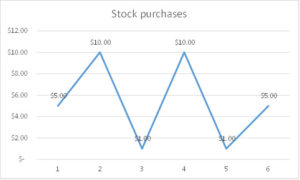Dollar Cost Averaging – Another Mathematical Phenomenon
A common mistake that investors make is in believing that a down market is always bad. It’s bad only if you are in the process of selling. For those in the accumulation phase, a down market actually represents opportunity. How sad it is to hear about the investor that has been building his portfolio only to find that it has declined significantly during a market downturn and then he makes the critical mistake; he sells.
 “After all,” Bob reasoned “I need to cut my losses. I’ve been investing regularly into this mutual fund that supposedly had a great track record and it’s gone down more than it’s gone up. In fact, my account is actually worth less than what I invested!” Here Bob had been building his portfolio with the discipline of regular monthly investing via his company 401k plan, but he lacked an understanding about the nature of investment markets and how to actually benefit from their fluctuation. As previously discussed, the goal is to buy low and sell high. And yet in a moment of panic, Bob sells low, the exact opposite of what he intellectually knew to be the prudent course of action. Why is it that intelligent people make such mistakes? Perhaps it’s because of the emotions of greed and fear. We all know about buy low, sell high. But because of these emotions we may take the wrong actions. How sad for Bob in that he ended-up exiting the market at the very moment when it was “the best of times,” the time of opportunity; the time when share prices were “on sale.” It was a time to be celebrating not panicking. Sometimes all it takes is having access to wise counsel to remind us of the greed and fear emotions and to keep us focused on the basic principles of investing, one of which is dollar cost averaging, a simple mathematical phenomenon that actually capitalizes on market fluctuations.
“After all,” Bob reasoned “I need to cut my losses. I’ve been investing regularly into this mutual fund that supposedly had a great track record and it’s gone down more than it’s gone up. In fact, my account is actually worth less than what I invested!” Here Bob had been building his portfolio with the discipline of regular monthly investing via his company 401k plan, but he lacked an understanding about the nature of investment markets and how to actually benefit from their fluctuation. As previously discussed, the goal is to buy low and sell high. And yet in a moment of panic, Bob sells low, the exact opposite of what he intellectually knew to be the prudent course of action. Why is it that intelligent people make such mistakes? Perhaps it’s because of the emotions of greed and fear. We all know about buy low, sell high. But because of these emotions we may take the wrong actions. How sad for Bob in that he ended-up exiting the market at the very moment when it was “the best of times,” the time of opportunity; the time when share prices were “on sale.” It was a time to be celebrating not panicking. Sometimes all it takes is having access to wise counsel to remind us of the greed and fear emotions and to keep us focused on the basic principles of investing, one of which is dollar cost averaging, a simple mathematical phenomenon that actually capitalizes on market fluctuations.
Simply stated, Dollar Cost Averaging (DCA) is the act of placing the same amount of dollars into the same portfolio of securities at regular intervals. For example, investing $1,000 per month into a balanced mutual fund.
Since the amount of shares that can be bought for a fixed amount of money varies inversely with their price, DCA leads to more shares being bought when their price is low and a smaller number of shares when they are expensive. As a mathematical result, DCA causes the average cost per share of the investments purchased to be lower than the average purchase price of those same shares. At this moment you’re probably asking yourself “What? How can that be?”
The best way to help you come to an understanding of this phenomenon is to play a little investing game together:
In this game you are going to answer yes or no to the idea of investing into a mutual fund for a brief six month period via Dollar Cost Averaging. The specific question is: Yes or no, would you invest $1000 each month for six months into this mutual fund and then sell all your shares at the sixth month’s price? Now, whereas a real-life investment decision would not have the benefit of knowing the prices for each month in advance, in this game you do have that information. Specifically, the prices are as follows:
Month 1: $5
Month 2: $10
Month 3: $1
Month 4: $10
Month 5: $1
Month 6: $5
If you say yes, then you will be purchasing your shares at a price of $5 on the first month, then $10, on the second month and so forth up to the sixth month where you will purchase the last of your shares at $5 each. Then you will sell all of you shares at the sixth month’s price of $5 and take your profits or losses. Following is a graphical depiction:

 So, given the benefit of advance knowledge, knowing precisely what the purchase and sale prices are, it’s now time to make the decision. Without looking on the next page, please make your decision, yes or no.
So, given the benefit of advance knowledge, knowing precisely what the purchase and sale prices are, it’s now time to make the decision. Without looking on the next page, please make your decision, yes or no.
Would you like to reconsider? Let’s do a quick calculation together before you decide again. Let’s calculate the average price per share during this six month period. The math is easy; we simply add each of the prices:
$5+10+1+10+1+5 = 32
To determine the average price we divide this sum by the number of purchases, 6:
32/6 = $5.33
So, knowing that the average purchase price would be $5.33 and the price you will be selling at is $5, what is your thinking now? Yes or no, would you make this investment?
Now let’s calculate the outcome of this investment and determine how much profit or loss there actually was. To do this we first must calculate the number of shares purchased. By dividing the price per share for each month into the $1,000 amount invested we can calculate the total by adding each result:
Month 1: $1,000/5 = 200
Month 2: $1,000/10 = 100
Month 3: $1,000/1 = 1000
Month 4: $1,000/10 = 100
Month 5: $1,000/1 = 1000
Month 6: $1,000/5 = 200
Total 2600 Shares
To calculate the value of these shares, we multiply by the sale price of $5:
$5 X 2600 = $13,000
To calculate the profit or loss we must subtract the total investment of $6,000:
$13,000 – 6,000 = $7,000
Wow! How does a go-nowhere investment (that starts at $5 per share and ends at the same value) produce a profit of over 100%? Especially when we know that the average price for a share during the period was $5.33 (33 cents higher than the sale price per share)?
The answer can be found by finally calculating the average cost per share. To do this we simply divide the total amount invested of $6000 by the number of shares purchased; 2600:
$6000 / 2600 = $2.31
 With an average cost of only $2.31 a sale price of $5.00 will naturally produce a significant profit (over 100%). So as explained earlier, the mathematical consequence of DCA is that the average cost per share ends up being less than the average purchase price per share. This can substantially improve your potential for profit, even if the investment seemingly goes nowhere; as long as there are fluctuations in value along the way.
With an average cost of only $2.31 a sale price of $5.00 will naturally produce a significant profit (over 100%). So as explained earlier, the mathematical consequence of DCA is that the average cost per share ends up being less than the average purchase price per share. This can substantially improve your potential for profit, even if the investment seemingly goes nowhere; as long as there are fluctuations in value along the way.
Of course, anyone would buy all the shares they could at an average of $2.31 if they knew for sure that they could soon afterwards sell them for $5 each. In real life, we don’t have the luxury of knowing in advance how an investment will perform. Of course if we do our due diligence (research), we can hopefully have a good idea of an investment’s potential. Also, real life rarely provides the extreme fluctuations offered in this particular investment game. But hopefully, you can now see how DCA is a simple way for you to take advantage of the fluctuating markets in which you will find your financial investments, namely your stocks, bonds and mutual funds. If our friend Bob had understood DCA, he might have realized that the down market in which he found himself was actually a wonderful opportunity for him to accumulate a greater proportion of his investment shares with the potential for greater profit in the future.
